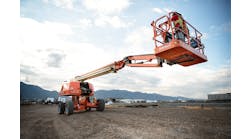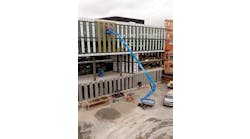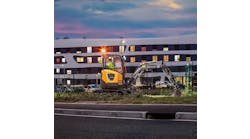Grand Winner
Lifts Category Winner
LiftPod
JLG Industries
Key Innovation: The first personal and portable aerial work platform (AWP) on the market to replace the ladder.
The LiftPod is the first personal and portable aerial work platform (AWP) on the market to replace the ladder. The price of the unit is 25-percent the cost and weight of an entry-level AWP. The LiftPod consists of three main sections — the base, the mast and carriage, and the platform — which are each about 55 pounds or less and can be assembled by one person in less than 30 seconds. Powered with a common 18-volt cordless drill, the LiftPod has a 14-foot working height and allows its user to work with both hands free in a 360-degree range of motion. The LiftPod’s lightweight and compact size allow for one person to move it around the worksite or transport it in the back of a pick-up truck with little effort. An optional power pack and a pair of quick-change batteries allow continuous work.
RER: What makes the LiftPod innovative?
Jeff Ford, senior manager, marketing communications JLG Industries: The LiftPod by JLG is the first personal and portable aerial work platform on the market to combine the portability of a ladder with the stability of a work platform. It is powered with any common 18-volt drill or with an optional power pack and is 25 percent the cost and weight of traditional work platforms.
RER: What are the benefits to the LiftPod? How does the unit make jobs more effective and efficient for rental professionals and their contractor customers?
Ford: The LiftPod is easy to assemble, portable and safer to use than ladders. Its enclosed basket gives workers a 360-degree range of motion at a 14-foot working height. An attachable work tray stores users’ tools and materials, allowing them to work with both hands.
At 145 pounds (not including the power pack), the LiftPod’s lightweight design and compact size allow for superior ease of movement around the work site on its nonmarking polyurethane wheels. A single person can assemble it in less than 30 seconds. When disassembled, the LiftPod can be transported site-to-site in the back of a pick-up truck, van or SUV.
The LiftPod consists of three main sections: the base, the mast and carriage, and the platform. The heavy-duty, powder-coated steel base weighs just 63 pounds. Its castor mechanism locks when the LiftPod is in use and provides mobility when it is set up. The mast (49 pounds) consists of aircraft-quality aluminum, and the platform (33 pounds) has a capacity of 330 pounds at maximum elevation.
RER: Describe the development process of the LiftPod. Where did the idea come from and who was responsible for its engineering and development?
Ford: The LiftPod was a JLG Industries, Inc. initiative. Its creation involved a collaboration of efforts – which included the product’s physical development, market research and testing – in Australia, followed by additional testing and final development by JLG in the United States. The LiftPod was initially introduced to the Australian market in 2007, where it won a WorkCover New South Wales Safe Work Award for “Best Solution to an Identified Workplace Health and Safety Issue.” The LiftPod was introduced to the U.S. market in 2008.
RER: Describe some applications where the LiftPod really improves workflow for the operator.
Ford: The LiftPod has seen early success in a number of applications, including lighting maintenance, facility maintenance, equipment repair and maintenance, and glass-replacement jobs for businesses and large vehicles. In addition, the LiftPod is an ideal product for several other applications, such as HVAC installation and maintenance, storage access, signage installation, siding repairs and installation, painting, cleaning, product stocking and removal, security system maintenance, decorating, window washing, and plant and floral care.
Because of its lightweight design, the LiftPod can be used in a number of different building types, including commercial office buildings, retail stores, warehouses, manufacturing facilities, shopping malls, schools and universities, hospitals, government buildings, apartment buildings and condominiums, hotels and resorts, convention centers, stadiums and parking ramps.
RER: Explain why using the LiftPod is more effective than using another lift unit.
Ford: The LiftPod is 25 percent the weight of traditional lifts, making it less cumbersome than traditional lifts, particularly when used in small work areas. More importantly, the LiftPod offers the stability and comfort not always found in ladders, allowing users to securely work with both hands while having easy access to their tools and materials. A design that consists of three main parts and a quick assemble/disassemble process also allows LiftPod users to work more efficiently as they move from job to job. The ability to operate the LiftPod with a common 18-volt drill or optional power pack provides added convenience while minimizing downtime on the job site.
RER: Are there any additional enhancements or features planned for the LiftPod? What can we expect of the unit in the future?
Ford: No changes are planned in the near term; there is potential for future product line expansion, based on input from our customers and additional research.






